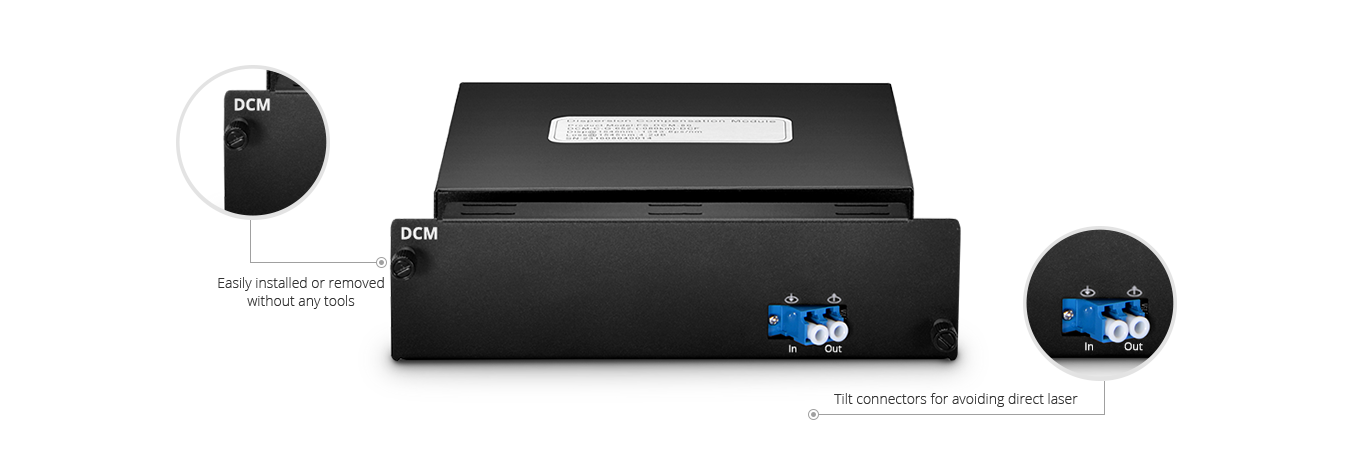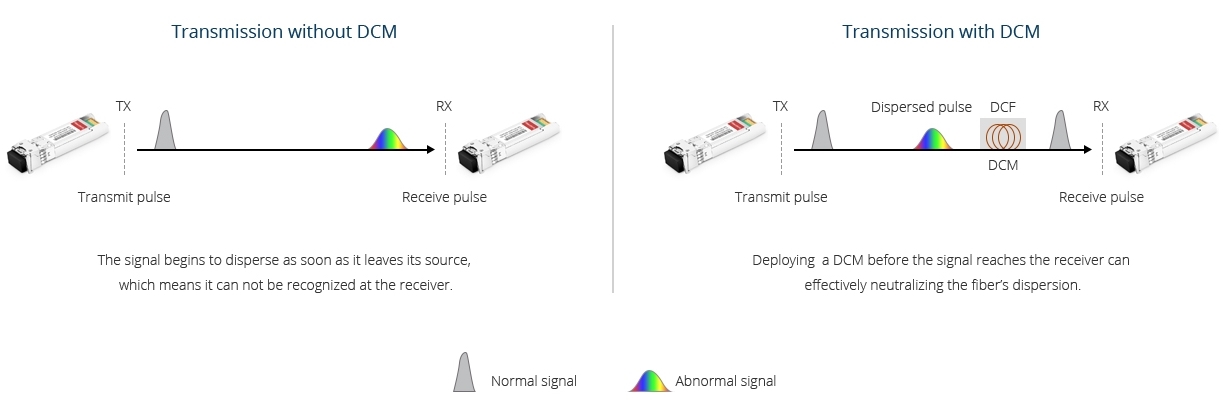Dispersion Compensation Module for Long-Haul DWDM System
In recent years, DWDM (dense wavelength division multiplexing) technology has made tremendous progress on transmission capacity, which is defined by optical signal modulation method and transmission bandwidth. As transmission speeds rise, implementing effective chromatic dispersion management becomes crucial to maintain signal integrity. This paper explores the types of dispersion and introduces solutions for long-haul DWDM systems.
Dispersion in DWDM Optical Transmission System
Dispersion is referred to as the broadening of light pulses and is a consequence of the physical properties of the transmission medium. When optical signals are transmitted over optical links, different wavelength components of the optical signals will generally experience different propagation times due to the fact that an optical fiber has different effective refractive indices for different wavelengths, which results in a pulse distortion and broadening. This phenomenon is referred to as dispersion. Dispersion reduces the effective bandwidth and escalates the error rate due to an increasing intersymbol interference, which has become a critical factor limiting the quality of signal transmission over optical links. There are mainly two kinds of dispersion in fiber optical transmission, Polarization Mode Dispersion (PMD) and Chromatic Dispersion (CD).
Chromatic Dispersion Basis
Polarization Mode Dispersion (PMD)
PMD is a form of dispersion where optical pulses are spread because optical signals in different phase states are transmitted at different speeds due to the random birefringence of optical fibers.
Chromatic Dispersion (CD)
CD is a form of dispersion where optical pulses are spread because different wavelengths are transmitted at different speeds in optical fibers and the periods for different wavelengths to traverse the same distance are different. Chromatic dispersion is the most significant impairment that should be considered in fiber transmission systems.
The following are some important properties of dispersion compensation:
-
Core Dispersion: The dispersion of the core is determined by the length and type of the compensated transmission fiber. For instance, dispersion-shifted fibers necessitate less dispersion compensation.
-
Dispersion Slope: Higher-Order dispersion, or dispersion slope, significantly restricts the available bandwidth, a critical factor in Wavelength Division Multiplexing (WDM) systems. Different transmission fibers require specific dispersion slopes. A higher dispersion slope can complicate fiber design.
-
Insertion Loss: Insertion loss arises from absorption, scattering within the fiber, and contributions from splices and connectors. It is crucial to minimize this loss as much as possible, since high amplifier gain is required to counteract it, which can introduce additional noise.
-
Optical Nonlinear Effects: Optical nonlinear effects can also play a role. Fibers with strong dispersion can mitigate these effects, making very short fibers effective.
-
Compact Structure: A compact structure is essential in practical applications. While compensating fibers can be tightly coiled, this is restricted by bending losses.
If you want to delve deeper into dispersion, you can check out this article: Types of Optical Fiber Dispersion and Compensation Strategies.
DCM - Solutions for Chromatic Dispersion Compensation
Nowadays, there are various methods allowing for dispersion compensation in fiber optics, such as dispersion compensation module (DCM), dispersion compensation fiber (DCF), typical bragg grating operation, chirped fiber bragg grating, etc. For fiber optical high bit rate (such as 10G or 40G bit/s) long-haul transmission systems, dispersion compensation module is one of the most important items to be considered for chromatic dispersion compensation. The dispersion compensating module compensates the cumulative dispersion in a single mode fiber and a dispersion coefficient is used to characterize the dispersion value. The value for regular single mode fiber is around +16~17ps/(nm*km) at 1550nm. To properly manage this, the DCM is built by using a special type of dispersion compensating fiber inside the module that has a negative value of dispersion coefficient, ranging from -30 to -300ps/(nm*km). The DCM can be used to compensate for chromatic dispersion from 10Mbps to 40Gbps data rates in ultra long haul coherent networks, such as SDH/SONET, CATV and DWDM systems. These modules can achieve -10 to -2100ps/nm of dispersion values at 1550nm wavelength and offer a high-level compensation for standard single mode fiber (SMF28 – G.652 fiber) across entire C-Band while maintaining an extremely low and flat insertion loss as well as low latency. When combined with EDFA and OEO, DCM provides a simple, reliable, and cost-effective long-haul transport solution, making signals go further without regeneration.

Figure 1: DCF-Based Passive Dispersion Compensation Module
Dispersion Compensation Module Use Case Study
As an example, the cumulative dispersion for a 10km length of fiber will be +160~170ps/nm, so in order to compensate for that amount of dispersion, a DCM module will be added to the link with a specific and calculated fiber length aimed at reducing the total dispersion close to 0ps/(nm*km).
As seen below, the signal begins to disperse as soon as it leaves the source, which means it can not be recognized at the receiver side. But with a DCM module, the lost signals can be compensated before the receiver can effectively neutralize the fiber’s dispersion, which eventually guarantees normal working and ensures reliable long-haul transmission.

Figure 2: Use Case of Dispersion Compensation Module
Typically, a DCM module provides a fixed amount of dispersion (e.g. normal dispersion in the 1.6-μm spectral region), although tunable dispersion modules are also available. A module can easily be inserted into a fiber-optic link because it has fiber connectors for the input and output. The insertion losses may be compensated with a fiber amplifier (e.g. an EDFA in a 1.5-μm telecom system). A dispersion compensation module is often placed between two fiber amplifiers in a long-haul DWDM system.
FS Dispersion Compensation Module Products
FS FMT Series Dispersion Compensation Module is engineered to correct optical signals deformed by chromatic dispersion. This module provides extensive compensation capabilities with low and flat insertion loss, ensuring signal integrity over long distances. When paired with EDFA and OEO, the FMT DCM extends signal reach significantly without the need for regeneration, making it an ideal choice for long-haul DWDM systems. FS also offers customized solutions to meet specific network requirements, with a variety of adjustable parameters such as compensation length, connector type, and housing options, ensuring precise adaptation and optimized performance for diverse applications.
Conclusion
In conclusion, dispersion compensation is crucial for maintaining signal integrity and minimizing errors in high-speed DWDM systems. Dispersion Compensation Modules play a vital role by counteracting chromatic dispersion, ensuring reliable long-haul transmission. As DWDM technology advances, robust chromatic dispersion management through chromatic dispersion compensators remains essential for achieving high-quality, long-distance optical communication.
You might be interested in
Email Address

-
PoE vs PoE+ vs PoE++ Switch: How to Choose?
May 30, 2024















